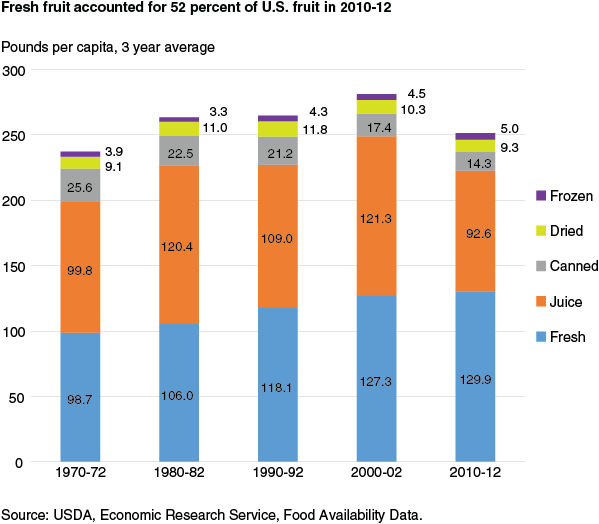Fresh Fruit Makes Up a Growing Share of U.S. Fruit Availability
- by Jeanine Bentley and Agnes Perez
- 5/4/2015
Fruit is an essential part of an overall healthy diet, providing vitamins, dietary fiber, and other nutrients integral to good health. Whole fruit is low in fat, sodium, and calories, and helps maintain healthy blood pressure and reduce blood cholesterol levels. While the 2010 Dietary Guidelines for Americans recommends 2 cups of fruit per day for a 2,000-calorie diet, food intake analyses by ERS finds that the average American consumes about half that amount.
According to ERS’s Food Availability data, per capita supplies of fruit available for consumption in the United States have fallen over the last decade after rising since the early 1970s. ERS annually calculates national supplies available for domestic consumption of 29 types of fruit by summing domestic production, beginning inventories, and imports and then subtracting exports and ending inventories. Per capita estimates are calculated by dividing these national supplies by the U.S. population. Decisions about what types of fruit to grow or import are driven, in part, by consumer demand. While expanded fruit-growing regions, new fruit varieties, and increased imports have led to greater U.S. supplies of some types of fruit, increased exports of U.S. fruit and decreased citrus production have contributed to lower total fruit availability in the United States. In 2010-12, per capita fruit availability was 251.1 pounds per person (fresh-weight equivalent), a 10.6-percent decrease from 2000-02.
Fresh fruit accounted for 52 percent of fruit availability in 2010-12, up from a 42-percent share in 1970-72. Bananas, apples, and oranges account for 40 percent of the fresh fruit available for consumption in 2010-12. Demand for other fruit—such as blueberries, avocados, limes, pineapples, cherries, lemons, papayas, and mangoes—has been more robust over the past decade, driving the growth in fresh fruit availability. Greater ethnic diversity of consumers looking for fruit for their traditional dishes and heightened interest in healthy diets helped spur this growth.
Processed fruit availability (canned, juice, frozen, and dried forms) has steadily fallen since reaching a peak of 171.3 pounds per person (fresh-weight equivalent) in 1977 to a low of 113.7 pounds in 2012. The bulk of the decline came from juice, which fell from 132.8 pounds per person in 1977 to 85.2 pounds per person in 2012. Per capita availability of orange juice, which accounts for half of U.S. fruit juice availability, declined by 53.6 pounds per person (54 percent) between 1977 and 2012. Diseases, primarily citrus canker and citrus greening, continue to plague the citrus industry, especially in Florida, the main supplier of U.S.-grown oranges for juice. Eradication efforts have resulted in reduced citrus acreage and declining U.S. citrus production. Increased U.S. production and imports of other types of fruits have not compensated for decreased U.S. citrus production, leading to a decline in total U.S. fruit availability over the last decade.
This article is drawn from:
- Food Availability (Per Capita) Data System. (n.d.). U.S. Department of Agriculture, Economic Research Service.
You may also like:
- Fruit and Tree Nuts Data. (n.d.). U.S. Department of Agriculture, Economic Research Service.


